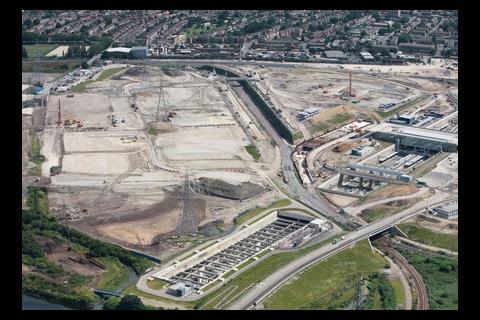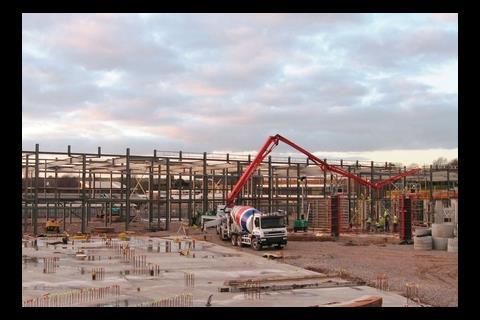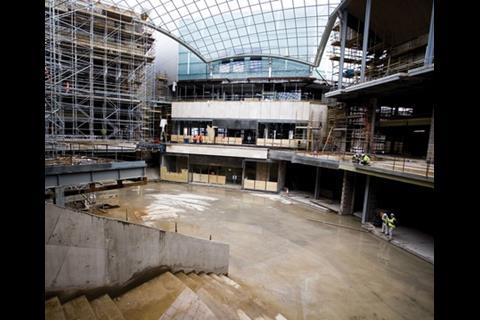On-site trailblazers such as Skanska, lend lease and Hammerson have already made strides towards reducing construction waste, through a variety of different approaches. Graham Ridout reports
Forward-thinking contractors and developers are already acting to reduce waste on construction projects, ahead of government targets. They have discovered that it is critical to plan sustainability into a project from as early a stage as possible if waste is to be most effectively minimised.
The design itself can have a big influence on reducing waste generation by specifying standard elements, as Skanska has done in its Bristol schools PFI project. Conversely, later changes in the design can be detrimental if it results in ordered materials being cut to fit.
Specification plays a critical role. This is not only in terms of sourcing materials with a high recycled content or from sustainable sources, as Hammerson has tried to do on its Highcross retail development in Leicester, but also in making sure that materials of as exact a size and quantity as possible are ordered to minimise wastage.
Once on site, sorting of waste materials into different streams is critical, and Lend Lease’s contribution to this as it works on the 2012 Athletes Village is subject to the rigorous monitoring of SWMPs. Even where this is not possible simply sending these to an appropriate recycling facility will divert tonnes of waste away from landfill.
Skanska’s recycling effort
As main contractor on a PFI project to build four new schools, Skanska and its client, Bristol City Council, have demonstrated what can be achieved if a rigorous approach is adopted to cutting waste, especially at the design stage.
Before the council invited tenders in January 2005, it undertook an analysis of the recycled content of materials used on previous secondary school projects. The analysis, by consultancy Davis Langdon, indicated that an increase in the recycled content to in excess of 20% could be achieved at no extra cost.
WRAP was also involved, commissioning research into prices of products that used either zero, little or a high level of recycled materials in their manufacture. The study revealed that in many cases brands with a higher recycled content were cheaper than rival brands with a low or zero recycled content.
Based on these studies, Bristol City Council stipulated in the tender documents that recycled products should account for at least 10% of the total cost of materials used in building the schools. This allowed bidders the flexibility to decide on the best design solution for each school without compromising on quality, cost or risk.
Skanska went on to win the £100m-plus project to build Bristol Brunel Academy, Brislington Enterprise College, Whitefield Fishponds Community School and Hartcliffe Education Campus. It is now on course to finish the fourth and final school, Hartcliffe, this December.
Apart from taking on board the higher recycled-content materials, Skanska’s design hinged on making best use of standardisation. Sustainability manager Greg Chant-Hall says: “On a previous school project, we used 45 types of doors. It sounds so simple but at Bristol we standardised the doors wherever possible, whether it was for durability, fire resistance or whatever.”
This reduced the number of door types specified to eight.
The same process of standardisation was carried out for the rest of the buildings’ components at design stage. Chant-Hall says: “There are thousands of elements in the buildings – walls, flooring, ceilings – and we wanted to standardise as much as possible and get an off-the-shelf design solution.”
He adds: “You can standardise the elements but still make them look distinct by clever design.”
The waste material was sorted into six streams – plasterboard, timber, metal, plastics, hardboard and cardboard. Separate bins were used for each material and provided at the workplace of the trade contractors. “It is all about site logistics and locating the bins where it is quickest and easiest for people to get rid of their waste,” says Chant-Hall.
He says trade contractors needed encouragement initially but adds: “We’ve found that firms will buy into the idea once it is explained to them.”
Chant-Hall says one of the targets was to reduce wastage on plasterboard to 10%. “It was quite a challenge but it’s achievable. We came to the conclusion that 10% was a reasonable benchmark. A lot of it is commonsense, such as working to minimise damage on site and correctly cutting plasterboard to size.”
Where possible, waste from demolition was crushed for reuse on site, with materials unsuitable for site reuse taken to a recycling plant. Chant-Hall says that Skanska would have liked to recycle more of these materials for on-site use but notes:
“With schools, that is not always possible because chronologically the demolition usually follows after the new school has been built.”
Another plan of action was to persuade manufacturers to minimise packaging coming on site. All packaging that did arrive was subsequently sent to an offsite recycling centre.
A full analysis of the effectiveness of the waste minimisation programme at Bristol will be carried out once the final completed school is handed over at the end of the year. However, such has been the success of the measures adopted in Bristol that Partnerships for Schools has specified that the 10% recycled content stipulation applied there should be a standard requirement for all projects in the Building Schools for the Future programme.
Hammerson’s materials focus
Hammerson’s £350m Highcross development in Leicester has left its green stamp on the county. The development, which opened in September, involved revamping 46,000m2 of the existing Shires shopping area and building 30,000m2 of new units.
The upgraded Shires and new mall extension are naturally ventilated, resulting in a 29% reduction in energy expenditure, and the specifications for the fit-out aim to deliver greater energy, waste and water efficiency. These measures have led to the centre gaining a BREEAM environmental rating of Very Good. It even has 105 charge points for electric cars.
Of equal importance are the construction materials specified for the development, which included up to 37% recycled or reused content.
Even so, Paul Edwards, head of sustainability at Hammerson, explains that when the scheme was conceived six years ago, no waste reduction targets were set. “It shows how far we’ve moved on,” he says. “One of the biggest problems is developing knowledge about minimising waste. We are learning all the time. We have to look to consolidate and get consistency of approach to solve the problems.”
For waste reduction to be effective, Edwards says it has to be incorporated at the start of the design, so components such as the size of the plasterboard can be standardised. “You don’t want 3m lengths of plasterboard when you need them 2.7m long,” he says. “To suddenly change the design part way through a project is very difficult.”
The principal areas targeted for action were demolition waste and hardcore, blockwork and concrete. But space restrictions meant there was no possibility of installing crushing plant on site to recycle the demolition waste.
As the development progressed and more information filtered through about minimising waste, some changes were made to the materials specification.
One such change was switching to blockwork that had a 75% recycled material content.
Edwards notes: “Some elements are harder to source because the industry hasn’t caught up yet.” But in other areas, sourcing sustainable materials was straightforward – almost 100% of the timber used was obtained from Forestry Stewardship Council suppliers.
Separate bins were used on site to collect recyclable materials such as timber, metal, plastics, paper and plasterboard. “We tried to push recycling as much as possible and every month we prepared an environmental report on what we had achieved,” says Edwards.
He says the fit-out process presented a dichotomy. “In retail, there are set standards for things like floor area and the distance between columns. These work well in retail terms, but are not necessarily effective for reducing waste.”
To illustrate the point, he cites Hammerson’s Cabot Circus retail development in Bristol. There, 22 tonnes of plasterboard went to waste from one retail outlet alone, indicating the scale of the problem. The development opened at the end of September and Edwards remarks: “We couldn’t change the upfront process.”
During the later stages of the Bristol mall, a waste-measuring programme was introduced that showed that 54% of waste generated was being recycled. As WRAP points out, this figure could have been improved if planned for in the early stages.
Edwards concedes: “Because both the Highcross and Cabot Circus schemes were conceived so long ago, we were chasing our tails as far as minimising waste was concerned.”
In spite of this, a WRAP study of the two developments indicated that Hammerson was ahead of the industry in using components containing recycled materials. Estimates prepared by Cyril Sweett indicated the value of these as a proportion of the total materials used in construction to be 32.6% at Leicester and 29.3% at Bristol.
It was further estimated that procuring the components with higher recycled content at the two developments led to materials totalling 1,000 tonnes being removed from the waste stream at Leicester and 1,700 tonnes at Bristol.
The study highlighted the use of components containing a high content of recycled material – concrete, concrete blocks, concrete paving, bricks and asphalt, which it termed “quick wins”.
The study reported: “If all the quick win opportunities were adopted, it would have been possible for a total of 10,000 tonnes of materials at Leicester and 6,700 tonnes at Bristol to be diverted.”
Limbering up for the Olympics
The Athletes Village now under construction in Stratford, east London, for the 2012 Olympic and Paralympic Games could play a significant role in raising industry-wide awareness about the importance of reducing waste.
The aim for all projects on the site is to minimise waste to less than 10m3 for every £100,000 spent on construction. The volume of waste in every skip leaving the site is being measured as part of the site waste management plans (SWMPs) being developed for each plot and project on the scheme.
Like Skanska and Hammerson, the project teams have been using WRAP’s Net Waste Tool to help them improve waste management efforts. Waste consignments are also being monitored by a customised version of the BRE’s SMARTWaste Plan, a web-based set of tools to track and manage waste on site. The tools can be used to provide an indication of forecast versus actual waste and calculate several key performance indicators.
These are just some plans being adopted by developer Lend Lease and its affordable housing partners, First Base and East Thames Group, on the two-phase project.
The first phase is under way and includes up to 3,300 residential dwellings. Handover to the Olympic Delivery Authority is scheduled for 2011. The second phase, which is due for completion in 2020, will transform the Athletes Village into a residential area featuring an education academy, community and healthcare facilities, and swathes of parks and open spaces.
Lend Lease’s prime objectives at the village are to minimise waste and increase the amount of recycled content contained in the materials used for construction.
One of the measures introduced to meet these objectives is evident with the onsite concrete batching plant. The aggregates used will have a recycled content of 20% and the amount of fresh cement required is being cut by using ground granulated blast furnace slag to provide 50% of the cementitious content in each batch of concrete.
None of the soil or excavated material is being taken off site, even though some of the ground is infected with Japanese knotweed. Material infected with the knotweed is no longer eligible for relief from landfill tax so it is being cleansed on site using a process developed by weedkiller specialist Klaro.
Klaro claims the process, licensed by the Environment Agency, is typically half the price of excavating and removing the soil to landfill. Lend Lease says it will also be able to claim a rebate on the cost of the treatment.
Although the site has good access to the road network, it is surrounded by rail lines. So another aim of the project is to reduce impact on surrounding roads by constructing a rail siding for the delivery of bulk materials.
Careful thought has been given during the design stage to minimising waste. Apart from specifying materials with a high recycled content, other initiatives include use of pre-fabricated bathroom pods and cladding methods.
Modular wiring systems have also been specified. The wiring looms will be manufactured off site so they can be easily plugged together on site. Their use, says Lend Lease, will reduce waste significantly and have a direct impact on the amount of labour required on site.
It is estimated that there will be a 20%-30% reduction in waste materials compared with a standard wiring system and installation time will be reduced by up to 20 hours per dwelling.
Contractors working on site received in their tender documentation an outline of Lend Lease’s aspirations and its requirements regarding reducing waste on site. The policy is being rolled out via induction courses, followed by onsite training and communications programmes. Contractors arriving on site at a later date will be expected to follow the same regime.
No Waste training
Stratford is also home to an extension of contractor Bovis Lend Lease’s Project NoWaste (NoW) initiative. NoW was set up to train operatives on all BLL sites up to National Vocational Qualification (NVQ) standard in waste management.
The NVQ pilot programme includes techniques to carry out routine upkeep of a site, improve and protect the environment, store materials, accept and collect waste, maintain working relationships and improve site safety.
Also under the initiative, presentations are given to supervisors and operatives. These sessions concentrate on more efficient use of site resources and waste reduction, lean construction methods, practical training issues and using a common language to discuss waste and its management.
As construction of the village is still in its infancy, no forecast has been set for the financial benefits that will accrue from the waste reduction strategies.
But one thing Lend Lease has set its sights on achieving is a higher environmental sustainability rating for the housing. Although only obliged to meet the requirements for a Code 3 rating under the Code for Sustainable Homes, the aim is to satisfy the standards for a Code 4 assessment.
The Wrap supplement 2008
- 1
- 2
 Currently reading
Currently readingThe work starts here
- 3
- 4
- 5
- 6
- 7
- 8
- 9
- 10
- 11







































No comments yet